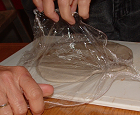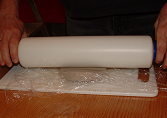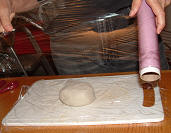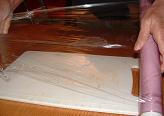| עברית |
|
|
|||||||||||||||||||||||||||
|
1. How should I flatten Keramikal and form a plain ? >> there are two simple ways (I,II) to form a Keramikal plain and you simply have to choose between them: ( I ) Rolling out on a cloth wrapped surface:
( II ) Rolling out between two plastic sheets:
* * *
2. How do I smoothen rough edges? >> Prior to baking (the piece being wet or dry) you may smoothen using wet finger, cloth or wet brush. Once baked, the piece may be polished using sanding paper. * * * 3. Sometimes while drying cracks might appear. Why does this happen and how should the piece be repaired? >> Keramikal, like any ceramic material, contains water. During the drying process water evaporates, the volume decreases, causing the piece to shrink slightly causing cracks.
* * * 4. I . By what colors should Keramikal be painted ? I I . Should Keramikal be painted before "baking" or afterwards? >> I . Recommended colors - Water paints, Gouash, Acrylic paints, glass paints etc. >> I I . Most artists find painting after "baking" preferable. Importent note: Since the variety of paints is immense, the behavior of the color should be tested on a small piece, before using. * * * 5. May water proof vessels such as flower pots be made from Keramikal? >> Vessels made from Keramikal may be filled with water but, in order to keep the vessel intact and avoid water dripping through the walls, it should be painted well by water proof color (or laque ) , such as acrylic, oil, or metal paints. (Make it a habit: a pre-test on a small sample first.) * * * 6. Does Keramikal contain poisonous components or gases? >>Keramikal is perfectly safe. It has gone through all necessary tests in the laboratories of the I.S.I (The Israeli Standards Institue) and was granted the European safety certificate CE FOR WATCHING THE CERTIFICATE, PRESS HERE * * * 7. Is Keramikal safe and Kosher for use inside the cooking oven? >> Keramikal does not contain animal parts or ingredients, so that there are no Kosher problems baking it in the same oven where home food is prepared. * * *
|
|||||||||||||||||||||||||||







